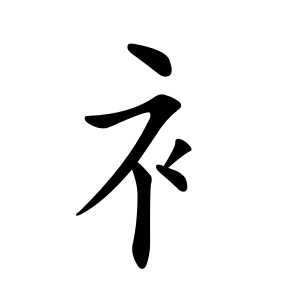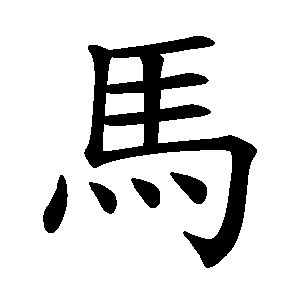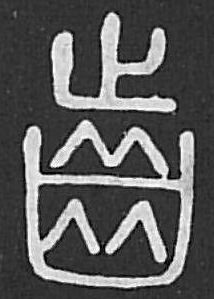|
Radical 130
Radical 130 or radical meat () meaning "meat" is one of the 29 Kangxi radicals (214 radicals in total) composed of 6 strokes. When used as a left component, the radical character transforms into in Simplified Chinese and Japanese or in modern Traditional Chinese used in Hong Kong and Taiwan. In the ''Kangxi Dictionary'', there are 674 characters (out of 49,030) to be found under this radical. is also the 132nd indexing component in the ''Table of Indexing Chinese Character Components'' predominantly adopted by Simplified Chinese dictionaries published in mainland China. Evolution File:肉-oracle.svg, Oracle bone script character File:肉-bronze.svg, Bronze script character File:肉-bigseal.svg, Large seal script character File:肉-seal.svg, Small seal script character Derived characters Variant forms This radical character has different forms in different languages when used as a left component. Traditionally, the writing form of the radical character as a left compone ... [...More Info...] [...Related Items...] OR: [Wikipedia] [Google] [Baidu] |
Radical 74
Radical 74 or radical moon () meaning "moon" or " month" is one of the 34 Kangxi radicals (214 radicals in total) composed of 4 strokes. In the ''Kangxi Dictionary''. there are 69 characters (out of 49,030) to be found under this radical. is also the 88th indexing component in the ''Table of Indexing Chinese Character Components'' predominantly adopted by Simplified Chinese dictionaries published in mainland China. Character with the alternative form of Kangxi Radical 130 ( "meat") is merged to this radical in Simplified Chinese, and no associated indexing component is left after the merger. Evolution File:月-oracle.svg, Oracle bone script character File:月-bronze.svg, Bronze script character File:月-bigseal.svg, Large seal script The large seal script or great seal script () is a traditional reference to Chinese writing from before the Qin dynasty (i.e. before 221 BCE), and is now popularly understood to refer narrowly to the writing of the Western and early Eastern ... [...More Info...] [...Related Items...] OR: [Wikipedia] [Google] [Baidu] |
Radical 104 ...
Radical 104 or radical sickness () meaning " sickness" is one of the 23 Kangxi radicals (214 radicals in total) composed of 5 strokes. In the ''Kangxi Dictionary'', there are 526 characters (out of 49,030) to be found under this radical. is also the 115th indexing component in the ''Table of Indexing Chinese Character Components'' predominantly adopted by Simplified Chinese dictionaries published in mainland China. Evolution File:疒-oracle.svg, Oracle bone script character File:疒-bronze.svg, Bronze script character File:疒-seal.svg, Small seal script character Derived characters Literature * * External links Unihan Database - U+7592 {{Simplified Chinese radicals 104 115 115 may refer to: * 115 (number), the number * AD 115, a year in the 2nd century AD * 115 BC, a year in the 2nd century BC * 115 (Hampshire Fortress) Corps Engineer Regiment, Royal Engineers, a unit in the UK Territorial Army * 115 (Leicestershire) ... [...More Info...] [...Related Items...] OR: [Wikipedia] [Google] [Baidu] |
Abbeville Publishing Group (Abbeville Press, Inc
Abbeville Publishing Group is an independent book publishing company specializing in fine art and illustrated books. Based in New York City, Abbeville publishes approximately 40 titles each year and has a catalogue of over 700 titles on art, architecture, design, travel, photography, parenting, and children's books A child ( : children) is a human being between the stages of birth and puberty, or between the developmental period of infancy and puberty. The legal definition of ''child'' generally refers to a minor, otherwise known as a person younge .... The company was founded in 1977 by Robert E. Abrams and his father Harry N. Abrams, who had previously founded the art book publishing company Harry N. Abrams, Inc. in 1949. Honors and awards bestowed upon Abbeville titles include the George Wittenborn Award for ''Art across America'' (1991). Imprints and divisions Abbeville Publishing Group's major imprint is Abbeville Press, which consists of art and illustrate ... [...More Info...] [...Related Items...] OR: [Wikipedia] [Google] [Baidu] |
Regular Style CJKV Radical 130 (1)
The term regular can mean normal or in accordance with rules. It may refer to: People * Moses Regular (born 1971), America football player Arts, entertainment, and media Music * "Regular" (Badfinger song) * Regular tunings of stringed instruments, tunings with equal intervals between the paired notes of successive open strings Other uses in arts, entertainment, and media * Regular character, a main character who appears more frequently and/or prominently than a recurring character * Regular division of the plane, a series of drawings by the Dutch artist M. C. Escher which began in 1936 * '' Regular Show'', an animated television sitcom * ''The Regular Guys'', a radio morning show Language * Regular inflection, the formation of derived forms such as plurals in ways that are typical for the language ** Regular verb * Regular script, the newest of the Chinese script styles Mathematics There are an extremely large number of unrelated notions of "regularity" in mathematics. ... [...More Info...] [...Related Items...] OR: [Wikipedia] [Google] [Baidu] |
Radical 145
Radical 145 or radical clothes () meaning " clothes" is one of the 29 Kangxi radicals (214 radicals in total) composed of 6 strokes. The radical character transforms into when appearing at the left side of a Chinese character. In the ''Kangxi Dictionary'', there are 607 characters (out of 49,030) to be found under this radical. is also the 142nd indexing component in the ''Table of Indexing Chinese Character Components'' predominantly adopted by Simplified Chinese dictionaries published in mainland China, with as its associated indexing component. Evolution File:衣-oracle.svg, Oracle bone script character File:衣-bronze.svg, Bronze script character File:衣-bigseal.svg, Large seal script character File:衣-seal.svg, Small seal script character Derived characters Literature * External links Unihan Database - U+8863 {{Simplified Chinese radicals 145 145 may refer to: *145 (number), a natural number *AD 145, a year in the 2nd century AD *145 BC, a year in the ... [...More Info...] [...Related Items...] OR: [Wikipedia] [Google] [Baidu] |
Radical 187
Radical 187 or radical horse () meaning "horse" is one of the 8 Kangxi radicals (214 radicals in total) composed of 10 strokes. In the Kangxi Dictionary, there are 472 characters (out of 49,030) to be found under this radical. , the simplified form of , is the 58th indexing component in the ''Table of Indexing Chinese Character Components'' predominantly adopted by Simplified Chinese dictionaries published in mainland China, while the traditional form is listed as its associated indexing component. The simplified form is derived from the cursive script form of . Evolution File:馬-oracle.svg, Oracle bone script character File:馬-bronze.svg, Bronze script character File:馬-bigseal.svg, Large seal script character File:馬-seal.svg, Small seal script character File:馬-xingshu.svg, Semi-cursive script Semi-cursive script (), also known as running hand script, is a style of calligraphy which emerged in China during the Han dynasty (3rd century BC – 3rd century AD). ... [...More Info...] [...Related Items...] OR: [Wikipedia] [Google] [Baidu] |
Radical 211
Radical 211 meaning "teeth" is the only one of the 214 Kangxi radicals that is composed of 15 strokes. In the Kangxi Dictionary there are only 21 characters (out of 40 000) to be found under this radical. Characters with Radical 211 Literature * *Leyi Li: "Tracing the Roots of Chinese Characters: 500 Cases". Beijing 1993, External links Unihan Database – U+9F52 Ancient forms of the character and list of Unicode characters with the radical. {{Kangxi Radicals 211
Year 211 ( CCXI) was a common year starting on Tuesday of the Julian calendar. At the time, in the Roman Empire it was known as the Year of the Consulship of Terentius and Ba ...
[...More Info...] [...Related Items...] OR: [Wikipedia] [Google] [Baidu] |
Radical 38
Radical 38 or radical woman () meaning "woman" or "female" is one of the 31 Kangxi radicals (214 radicals total) composed of three strokes. In the ''Kangxi Dictionary'', there are 681 characters (out of 49,030) to be found under this radical. is also the 56th indexing component in the ''Table of Indexing Chinese Character Components'' predominantly adopted by Simplified Chinese dictionaries published in mainland China. Evolution File:女-oracle.svg, Oracle bone script character File:女-bronze.svg, Bronze script character File:女-bigseal.svg, Large seal script character File:女-seal.svg, Small seal script character Derived characters Controversies over sexism Some feminists have claimed that many Chinese characters under radical woman are pejorative, (slave), (demon), (JP: , envy), (Simp.: , rape, traitor), (dislike) for example, and learning and using them may unconsciously lead to misogyny. Some have even proposed a reform of these characters. In 2010, a mainlan ... [...More Info...] [...Related Items...] OR: [Wikipedia] [Google] [Baidu] |
Radical 9
Radical 9 or radical man () meaning "person" is a Kangxi radicals. Of the 214 radicals, Radical 9 is one of 23 which are composed of 2 strokes. When appearing at the left side of a Chinese character, it usually transforms into . In the ''Kangxi Dictionary'', there are 794 characters (out of 49,030) to be found under this radical. is also the 12th indexing component in the ''Table of Indexing Chinese Character Components'' predominantly adopted by Simplified Chinese dictionaries published in mainland China. Two associated indexing components, and (formerly Radical 11), are affiliated to the principle indexing component . Evolution File:人-bronze-shang.svg, Shang bronze script character File:人-oracle.svg, Shang oracle bone script character File:人-bronze.svg, Western Zhou bronze script character File:人-bronze-warring.svg, Warring States bronze script character File:人-silk.svg, Chu slip script character of Warring States File:人-slip.svg, Qin slip script character o ... [...More Info...] [...Related Items...] OR: [Wikipedia] [Google] [Baidu] |
Radical 30
Radical 30 or radical mouth () meaning "mouth" is one of 31 of the 214 Kangxi radicals that are composed of 3 strokes. In the ''Kangxi Dictionary'', there are 1,146 characters (out of 40 000) to be found under this radical. is also the 37th indexing component in the ''Table of Indexing Chinese Character Components'' predominantly adopted by Simplified Chinese dictionaries published in mainland China. Evolution File:口-oracle.svg, Oracle bone script character File:口-bronze.svg, Bronze script character File:口-bigseal.svg, Large seal script character File:口-seal.svg, Small seal script The small seal script (), or Qin script (, ''Qínzhuàn''), is an archaic form of Chinese calligraphy. It was standardized and promulgated as a national standard by the government of Qin Shi Huang, the founder of the Chinese Qin dynasty. Name ... character Derived characters Literature * *Leyi Li: "Tracing the Roots of Chinese Characters: 500 Cases". Beijing 1993, External l ... [...More Info...] [...Related Items...] OR: [Wikipedia] [Google] [Baidu] |
Radical 5
Radical 5 or radical second () meaning "second" is one of 6 of the 214 Kangxi radicals that are composed of only one stroke. However, this radical is mainly used to categorize miscellaneous characters otherwise not belonging to any radical, mainly featuring a hook or fold, and 乙 is the character with the least amount of strokes. In the ancient Chinese cyclic character numeral system, 乙 represents the second Celestial stem (天干 ''tiāngān''). In the ''Kangxi Dictionary'', there are 42 characters (out of 49,030) to be found under this radical. In mainland China, along with other 14 associated indexing components, including , , etc., are affiliated to a new radical (), which is the 5th principal indexing component in the ''Table of Indexing Chinese Character Components'' predominantly adopted by Simplified Chinese dictionaries.GF 0011-2009 汉字部首表 ( The Table of Indexing Chinese Character Component ) Usually, only several out of the 15 variant components are ... [...More Info...] [...Related Items...] OR: [Wikipedia] [Google] [Baidu] |
Radical 19
Radical 19 or radical power () meaning "power" or "force" is one of the 23 Kangxi radicals (214 radicals total) composed of 2 strokes. In the ''Kangxi Dictionary'', there are 163 characters (out of 49,030) to be found under this radical. is also the 23rd indexing component in the ''Table of Indexing Chinese Character Components'' predominantly adopted by Simplified Chinese dictionaries published in mainland China. Evolution File:力-w.svg, Bronze script character File:力-bigseal.svg, Large seal script character File:力-seal.svg, Small seal script character Derived characters Literature * *Leyi Li: “Tracing the Roots of Chinese Characters: 500 Cases”. Beijing 1993, External links Unihan Database - U+529B {{Simplified Chinese radicals 019 Nineteen or 19 may refer to: * 19 (number), the natural number following 18 and preceding 20 * one of the years 19 BC, AD 19, 1919, 2019 Films * ''19'' (film), a 2001 Japanese film * ''Nineteen'' (film), a 1987 scie ... [...More Info...] [...Related Items...] OR: [Wikipedia] [Google] [Baidu] |


